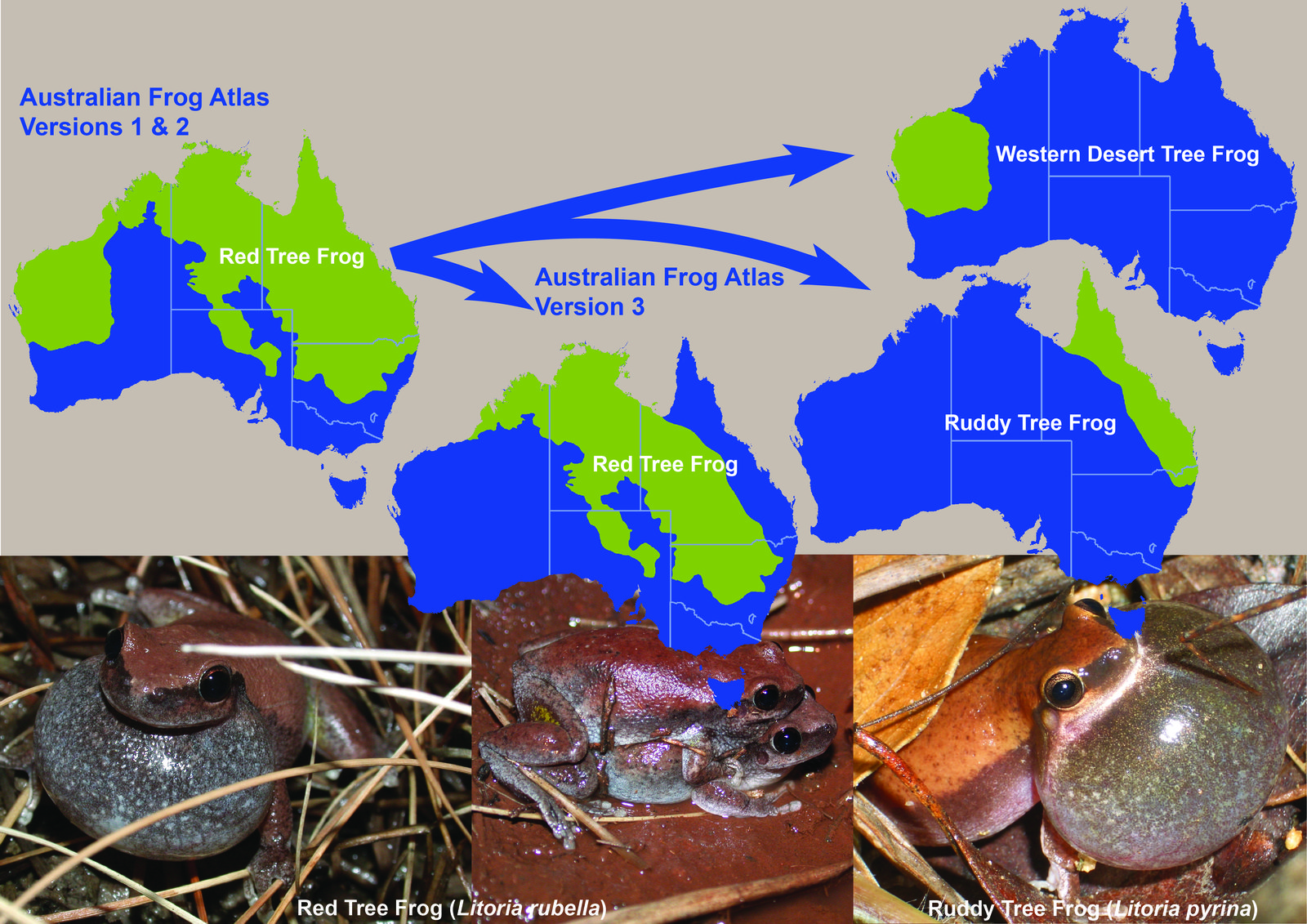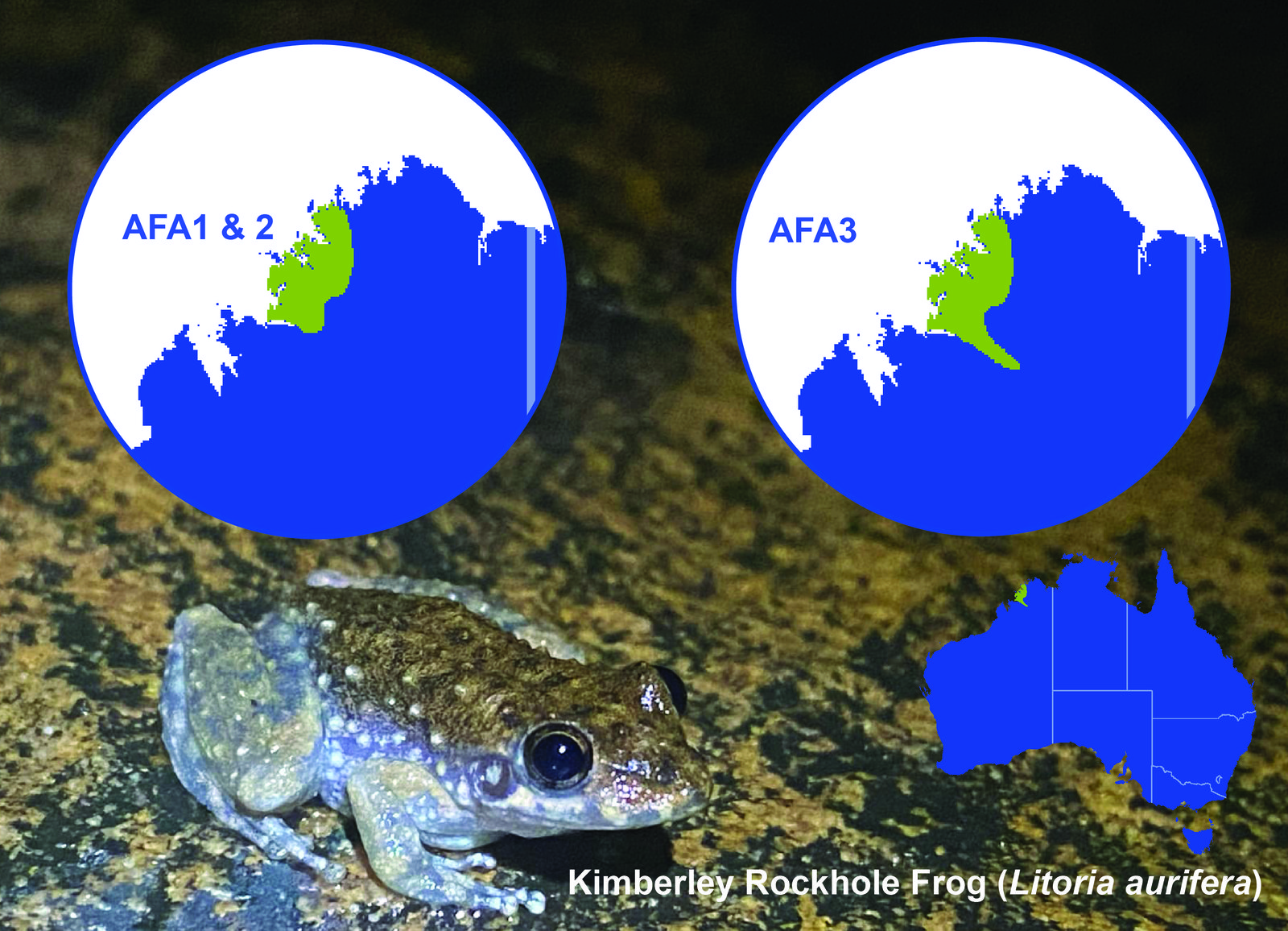Putting Frogs on the map: the Australian Frog Atlas
Introducing Version 3.0 of the Australian Frog Atlas – detailed distribution maps for all 257 of Australia’s native frog species, and the introduced Cane Toad, available to download here.

© Australian Museum
Information is key to survival
Frogs represent one of the most threatened vertebrate groups, with 1 in 5 described species threatened with extinction. In 2022, to assist conservation efforts, the Australian Museum released the Australian Frog Atlas, which at the time, was the most detailed distribution maps of Australian frogs. This year, the Australian Frog Atlas has been updated again to reflect the wealth of data collected from FrogID, the Australian Museum’s citizen science project, which has rapidly amassed frog occurrence data (now over 1.3 million frog records!), and recent taxonomic revisions of Australian frog species.
New findings
This new Atlas incorporates changes to over one third of Australia’s native frog species and includes the latest invasion front of the introduced Cane Toad (Rhinella marina) as determined by FrogID recordings. This version also includes the distributions of four species which have now been scientifically described – the Ruddy Tree Frog (Litoria pyrina), Western Desert Tree Frog (Litoria larisonans), Eungella Whirring Tree Frog (Litoria eungellensis), and the Atherton Tablelands Whirring Tree Frog (Litoria corbeni). By including these newly-described species in the updated version of the Australian Frog Atlas, we now have detailed distribution maps for all 258 described frog species in Australia.

© Australian Museum
Citizen science to the rescue
While the majority of updates to the distribution maps have been relatively small map revisions based on new FrogID records, there are many notable exceptions. For example, a new FrogID recording from the Kimberley region – an area which is poorly-known for frogs – has resulted in an 80km south-east range extension for the Kimberley Rockhole Frog (Litoria aurifera). This species is rarely encountered, with fewer than ten occurrences in the FrogID database, so being able to expand on our knowledge of the distribution of this species is very exciting.
FrogID recordings from poorly-sampled, remote areas of the country have also been essential for many of our other map revisions. Thanks to citizen scientists recording frogs in areas with no previous FrogID records, we’ve been able to revise the distribution maps of the Western Laughing Tree Frog (Litoria ridibunda), Pallid Rocket Frog (Litoria pallida), and Main’s Frog (Cyclorana maini), just to name a few. For the Main’s Frog (Cyclorana maini), these revisions have included a 230km extension in the south-west of its range, and nearly 60km extension in the south-east! To date, FrogID has received recordings of frogs from nearly 40% of Australia (see the spatial coverage map here), which is an incredible feat, but still leaves a large proportion of the country unsampled. Understanding more about the frogs which inhabit the remaining 60% of Australia will be essential as we continue to improve our knowledge of species distributions and continue to revise the Australian Frog Atlas in the years to come.

© Ian Bool
Explore the atlas
The updated version of the Australian Frog Atlas is Open Access and available to download. These publicly-available resources include detailed KML files, shapefiles, and a map of species richness across Australia. By submitting recordings to the FrogID app, thousands of citizen scientists are really helping to put Australian frogs on the map, expanding our knowledge and understanding of frog distributions, and helping to conserve some of Australia’s most threatened biodiversity.
Grace Gillard, Technical Officer, Herpetology, Australian Museum Research Institute
Dr Jodi Rowley, Curator, Amphibian and Reptile Conservation Biology, Australian Museum & UNSW Sydney. Lead Scientist, FrogID.
Acknowledgements:
We would like to thank the Citizen Science Grants of the Australian Government and the Impact Grants program of IBM Australia for providing funding and resources to help build the initial FrogID App; the generous donors who have provided funding for the project; the Museum and Art Gallery of the Northern Territory, Queensland Museum, South Australian Museum, Tasmanian Museum and Art Gallery, and Western Australian Museum as FrogID partner museums; the many Australian Museum staff and volunteers who make up the FrogID team; and, most importantly, the thousands of citizen scientists across Australia who have volunteered their time to record frog calls with FrogID.
More information:
- Australian Frog Atlas 3.0
- Cutajar, T.P., Portway, C.D., Gillard, G.L., and Rowley, J.J.L. (2022) Australian Frog Atlas: Species’ distribution maps informed by the FrogID Dataset. Technical Reports of the Australian Museum, Online 36: 1-48. https://doi.org/10.3853/j.1835-4211.36.2022.1789.













